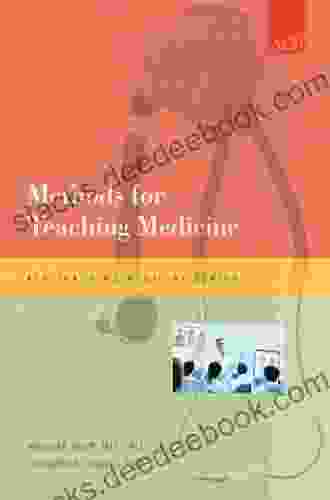Methods For Teaching Medicine: A Comprehensive Guide to Effective Medical Education

The field of medicine is constantly evolving, demanding medical educators to employ innovative and effective teaching methods to prepare future healthcare professionals. This article provides a comprehensive overview of various methods used in medical education, exploring their advantages, disadvantages, and best practices.
4.5 out of 5
| Language | : | English |
| File size | : | 954 KB |
| Text-to-Speech | : | Enabled |
| Enhanced typesetting | : | Enabled |
| Print length | : | 141 pages |
| Lending | : | Enabled |
| Screen Reader | : | Supported |
Learner-Centered Teaching
Learner-centered teaching places the student at the center of the learning experience. Educators prioritize students' individual needs and learning styles, fostering an environment where students actively engage in their education.
Advantages
- Promotes student engagement and motivation
- Tailors instruction to individual learning needs
- Encourages critical thinking and problem-solving
Disadvantages
- Can be time-consuming to implement
- May require additional resources and support
Best Practices
- Incorporate student self-assessment and reflection
- Provide students with choices and flexibility in learning activities
- Use technology to enhance student engagement and personalization
Problem-Based Learning
Problem-based learning (PBL) engages students in solving real-world medical problems, fostering critical thinking, problem-solving, and self-directed learning.
Advantages
- Develops problem-solving skills and clinical reasoning
- Enhances student motivation and engagement
- Promotes teamwork and collaboration
Disadvantages
- Can be time-consuming and resource-intensive
- Requires a well-designed curriculum and skilled facilitators
Best Practices
- Use well-structured clinical scenarios
- Provide students with appropriate resources and guidance
li>Promote student collaboration and peer feedback
Case-Based Learning
Case-based learning presents students with clinical cases to analyze, diagnose, and treat. It emphasizes clinical decision-making, critical thinking, and communication skills.
Advantages
- Enhances clinical reasoning and problem-solving
- Develops communication and interpersonal skills
- Promotes lifelong learning and self-directed study
Disadvantages
- May require extensive preparation and resources
- Can be challenging for students with limited clinical experience
Best Practices
- Use authentic clinical cases that reflect real-world scenarios
- Encourage student discussion and collaboration
- Provide structured debriefing sessions to enhance learning
Simulation-Based Learning
Simulation-based learning creates realistic clinical environments using simulators, virtual reality, or standardized patients. It allows students to practice clinical skills, decision-making, and communication in a safe and controlled setting.
Advantages
- Provides a safe and controlled environment for skill development
- Enhances clinical reasoning and decision-making
- Reduces patient harm and improves patient safety
Disadvantages
- Can be expensive and resource-intensive
- May not fully replicate the complexities of real-world clinical settings
Best Practices
- Use high-fidelity simulators and realistic clinical scenarios
- Provide structured feedback and debriefing sessions
- Integrate simulation-based learning into the overall medical curriculum
Online Learning
Online learning utilizes technology to deliver educational content and facilitate interaction between students and instructors. It offers flexibility, accessibility, and customization.
Advantages
- Provides greater flexibility and accessibility
- Allows for personalized and self-paced learning
- Facilitates collaboration and peer-to-peer learning
Disadvantages
- May lack the personal interaction and hands-on experiences of traditional learning
- Requires access to technology and reliable internet
Best Practices
- Use interactive and engaging online materials
- Provide clear communication and timely feedback
- Incorporate opportunities for student interaction and collaboration
Blended Learning
Blended learning combines traditional face-to-face teaching with online learning, offering the advantages of both modes. It provides flexibility while ensuring face-to-face interaction and hands-on experiences.
Advantages
- Combines the benefits of traditional and online learning
- Provides flexibility and accessibility
- Promotes student engagement and motivation
Disadvantages
- Requires careful planning and coordination
- May not be suitable for all learners or learning objectives
Best Practices
- Clearly define the roles of face-to-face and online components
- Use technology to enhance student learning and engagement
- Provide support and guidance to students throughout the blended learning experience
Flipped Classroom
In the flipped classroom model, students prepare for class by engaging with online materials and come to class ready to discuss and apply concepts. This approach emphasizes active learning and student-centered instruction.
Advantages
- Increases student engagement and active learning
- Provides flexibility and personalization
- Promotes critical thinking and problem-solving
Disadvantages
- Can be challenging for students with limited self-discipline
- May require additional time for lesson preparation and planning
Best Practices
- Design engaging and interactive online materials
- Use class time for active learning and discussion
- Provide clear guidance and expectations to students
Reflective Practice
Reflective practice encourages students to critically examine their own learning experiences, knowledge, and skills. It promotes self-awareness, lifelong learning, and professional development.
Advantages
- Enhances self-awareness and critical thinking
- Promotes lifelong learning and professional development
- Improves student engagement and motivation
Disadvantages
- Can be time-consuming and challenging for students
- Requires a supportive learning environment
Best Practices
- Incorporate reflective activities into the curriculum
- Provide students with opportunities for self-assessment and feedback
- Create a supportive environment where students feel comfortable reflecting
The choice of teaching method in medical education depends on various factors, including the learning objectives, student characteristics, and available resources. Effective educators employ a variety of methods to cater to diverse learning styles and optimize student outcomes. By understanding the advantages, disadvantages, and best practices of each method, medical educators can design and implement engaging and effective learning experiences.
4.5 out of 5
| Language | : | English |
| File size | : | 954 KB |
| Text-to-Speech | : | Enabled |
| Enhanced typesetting | : | Enabled |
| Print length | : | 141 pages |
| Lending | : | Enabled |
| Screen Reader | : | Supported |
Do you want to contribute by writing guest posts on this blog?
Please contact us and send us a resume of previous articles that you have written.
 Book
Book Novel
Novel Page
Page Reader
Reader Paperback
Paperback E-book
E-book Newspaper
Newspaper Paragraph
Paragraph Sentence
Sentence Bibliography
Bibliography Preface
Preface Synopsis
Synopsis Footnote
Footnote Manuscript
Manuscript Scroll
Scroll Codex
Codex Tome
Tome Bestseller
Bestseller Biography
Biography Autobiography
Autobiography Memoir
Memoir Thesaurus
Thesaurus Character
Character Catalog
Catalog Card Catalog
Card Catalog Borrowing
Borrowing Stacks
Stacks Archives
Archives Periodicals
Periodicals Research
Research Reserve
Reserve Academic
Academic Journals
Journals Rare Books
Rare Books Interlibrary
Interlibrary Thesis
Thesis Storytelling
Storytelling Awards
Awards Theory
Theory Textbooks
Textbooks Rob Pate
Rob Pate Paul Polak
Paul Polak C Ernest Fayle
C Ernest Fayle Allen W Trelease
Allen W Trelease Billie Letts
Billie Letts Glenn J Dorn
Glenn J Dorn Rene Schreiber
Rene Schreiber Kathleen O Neal Gear
Kathleen O Neal Gear Daniel Aston
Daniel Aston Stephen Coonts
Stephen Coonts Anna Quindlen
Anna Quindlen Terence T Gorski
Terence T Gorski Leisa Wallace
Leisa Wallace Theo Christodoulou
Theo Christodoulou Fraser J Hay
Fraser J Hay Mark Bego
Mark Bego Ola Gjeilo
Ola Gjeilo Richard Lawry
Richard Lawry Moshe Lewin
Moshe Lewin Angelica Galbraith
Angelica Galbraith
Light bulbAdvertise smarter! Our strategic ad space ensures maximum exposure. Reserve your spot today!

 Warren BellA Stroll Through London Town: A Detailed Exploration of Barbara Connor's 1907...
Warren BellA Stroll Through London Town: A Detailed Exploration of Barbara Connor's 1907... Vic ParkerFollow ·12.1k
Vic ParkerFollow ·12.1k Troy SimmonsFollow ·15k
Troy SimmonsFollow ·15k Chris ColemanFollow ·4.1k
Chris ColemanFollow ·4.1k Greg CoxFollow ·19.4k
Greg CoxFollow ·19.4k Geoffrey BlairFollow ·7k
Geoffrey BlairFollow ·7k Arthur Conan DoyleFollow ·17.7k
Arthur Conan DoyleFollow ·17.7k Vincent MitchellFollow ·8.2k
Vincent MitchellFollow ·8.2k Dwight BellFollow ·15.8k
Dwight BellFollow ·15.8k

 Amir Simmons
Amir SimmonsMore Zeal Than Discretion: A Closer Look at the Risks and...
Enthusiasm is often seen as a positive...

 Wayne Carter
Wayne CarterYear of the Dog: American Poets Continuum 178
Year of the Dog is a...

 David Foster Wallace
David Foster WallaceThe Constitution of the State of New York: A...
The Constitution of the...

 Harvey Bell
Harvey BellSmall Cetaceans of Japan: Exploitation and Biology
Small cetaceans, including...

 Blake Bell
Blake BellEffortless Elegance: A Comprehensive Guide to Captivating...
In the realm of crocheting,...
4.5 out of 5
| Language | : | English |
| File size | : | 954 KB |
| Text-to-Speech | : | Enabled |
| Enhanced typesetting | : | Enabled |
| Print length | : | 141 pages |
| Lending | : | Enabled |
| Screen Reader | : | Supported |











